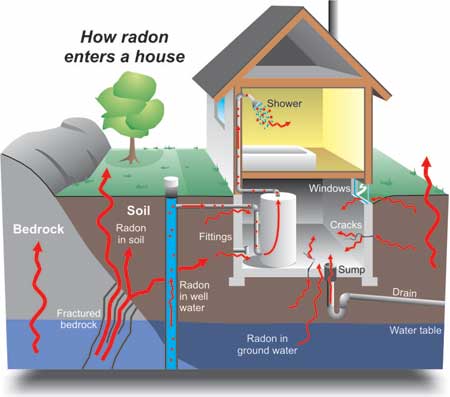Questions and Answers about Radon (Rn)
What is Radon and Radon Mitigation?
Radon is a naturally occurring noble gas, that is a decay product of uranium and radium. It is a colorless, odorless, tasteless and radioactive gas that could lead to serious health concerns. Radon mitigation is any process used to reduce radon gas concentrations in the breathing zones of occupied buildings, or radon from water supplies.
Radon is present outdoors and indoors as a naturally occurring part of our environment. It is normally found at very low levels in outdoor air and in drinking water from rivers and lakes. It can also be found at higher levels in the air in buildings, as well as in water from underground sources.
How Does Radon Get Into My Home?
Radon is widespread in homes in the United States – on average, 1 of every 15 homes have radon levels that are higher than the recommended action levels. Much of Ohio’s soil contains quantities of uranium and radium, both of which continuously break down and release radon gas.
Soil is porous, so radon moves up from the soil and into the home. Radon gets into buildings because the air pressure inside is usually lower than the pressure in the soil surrounding it. This difference causes the building to act like a vacuum and suck radon in through foundation cracks and other small openings such as gaps around pipes, cavities inside walls and the water supply.
Most radon exposure occurs inside homes, schools and workplaces – places where people and pets spend most of their time. Modern construction is not exempt from radon risks, as new insulation strategies often trap radon gas more effectively in new homes than older homes. Radon exposure can happen in any type of building, whether it has a basement, a crawl space, or is built on a slab. Testing is the only way to know your property’s radon levels.
Why Should I Test for Radon?
Radon gas does not have color, taste, or smell, and therefore is not detectable by human senses alone. However, indoor radon can be controlled and managed with proven, cost-effective techniques. There are simple steps you can take to control the amount of radon in your home.
The first step would be testing for radon. The U.S. Environmental Protection Agency (US EPA) , Surgeon General, American Lung Association, American Medical Association, and National Safety Council recommend testing all homes for radon. Testing is the only way to determine radon levels because each house is different. You cannot predict radon levels based on state, local, and neighborhood radon measurements. Even if your neighbor’s home has acceptable levels of radon, it does not mean your house would show the same results. After test completion, you will know whether further steps are necessary.
If you need professional radon testing, you can contact us easily via this contact form. We provide free, nonbinding price estimates. We can consult you on the best solution for your conrete property, saving you extra efforts and financial resources.
What is a Safe Level of Radon?
According to US EPA: “Any radon exposure has some risk of causing lung cancer. The lower the radon level in your home, the lower your family’s risk of lung cancer.” However, there are standard radon levels that can make it easier to calculate your expolsure risk.
We measure the concentration of radon in the air in units of picocuries per litre (pCi/L). A pCi is a measure of the rate of radioactive decay of radon. US EPA recommends taking action if your test results show radon levels of 4 pCi/L or higher. At this level, there will be approximately 12,672 radioactive disintegrations in one liter of air during a 24-hour period. Yet, you may consider taking further actions if the levels are between 2 and 4 pCi/L. Levels 2 pCi/L and under are consider safe without further actions but you still need to test your home every two years.
What if My Test Results Come Back High?
Don’t panic if your radon levels turn out to be too high – existent radon problems can be fixed relatively quickly and inexpensive! Contact us at Ohio Radon Mitigation: We will design and install a mitigation system that is specific and effective for your home. Every home is unique and will require an on-site consultation so we can develop the best plan to reduce your radon levels.
Do I Need a Radon Reduction System?
The answer is YES, if your test shows that radon levels are 4 pCi/L or higher. You may consider installing a radon mitigation system if the levels are between 2 and 4 pCi/L. Levels 2 pCi/L and under are consider safe without further actions. However, you still need to test your home very couple of years because radon levels change over time.
Professional radon systems can reduce radon levels in your home by up to 99 percent. While results vary, radon reduction systems are the most efficient way to mitigate your property. Most homes can be fixed for about the same cost as other common home repairs. Your costs may vary depending on the size and design of your home and which radon reduction methods are needed.
How Do Radon Systems Work?
There are different radon mitigation techniques. Active Subslab suction — also called sub slab depressurization — is the most common and usually the most reliable radon reduction method. One or more suction pipes are inserted through the floor slab into the crushed rock or soil underneath. We may also insert them below the concrete slab from outside the home. The number and location of suction pipes depends on how easily air can move in the crushed rock or soil under the slab and on the strength of the radon source. Often, all you need is a single suction point.


